1、什么是JUC
JUC就是java.util.concurrent下面的类包,专门用于多线程的开发。
java.util包下的三个工具类:
- java.util.concurrent
- java.util.concurrent.atomic
- java.util.concurrent.locks
2、线程和进程
进程是操作系统中的应用程序、是资源分配的基本单位,线程是用来执行具体的任务和功能,是CPU调度和分派的最小单位
一个进程往往可以包含多个线程,至少包含一个
例如:
进程:一个程序,QQ.exe Music.exe 程序的集合;
一个进程往往可以包含多个线程,至少包含一个!
Java默认有几个线程?
2个,main线程、GC线程
线程:开了一个进程 Typora,写字,自动保存(线程负责的)
对于Java而言启动线程:Thread、Runnable、Callable
Java 真的可以开启线程吗?
开不了。Java是没有权限去开启线程、操作硬件的,这是一个native的一个本地方法,它调用的底层的C++代码。
start底层代码:
public synchronized void start() {
/**
* This method is not invoked for the main method thread or "system"
* group threads created/set up by the VM. Any new functionality added
* to this method in the future may have to also be added to the VM.
*
* A zero status value corresponds to state "NEW".
*/
if (threadStatus != 0)
throw new IllegalThreadStateException();
/* Notify the group that this thread is about to be started
* so that it can be added to the group's list of threads
* and the group's unstarted count can be decremented. */
group.add(this);
boolean started = false;
try {
start0();
started = true;
} finally {
try {
if (!started) {
group.threadStartFailed(this);
}
} catch (Throwable ignore) {
/* do nothing. If start0 threw a Throwable then
it will be passed up the call stack */
}
}
}
//这是一个C++底层,Java是没有权限操作底层硬件的 (重点)
private native void start0();
2.1 并发和并行
并发:多个任务在同一个CPU 核上,按细分的时间片轮流(交替)执行,从逻编上来看那些任务是同时执行。
- 多线程操作同一个资源
- CPU 一核 ,模拟出来多条线程,天下武功,唯快不破,快速交替
并行: 单位时间内,多个处理器或多核处理器同时处理多个任务, 是真正意义上的“同时进行” 。
- 多个人一起行走
- CPU 多核 ,多个线程可以同时执行; 线程池
补充
并发

并行

串行
有n个任务, 由一个线程按顺序执行。由于任务、方法都在一个线程执行,所以不存在线程不安全情况,也就不存在临界区的问题。

获取cpu的核数
public class Test1 {
public static void main(String[] args) {
// 获取cpu的核数
// CPU 密集型,IO密集型
System.out.println(Runtime.getRuntime().availableProcessors());
}
}
2.2 线程有几个状态
Thread.State.**
public enum State {
//运行
NEW,
//运行
RUNNABLE,
//阻塞
BLOCKED,
//等待
WAITING,
//超时等待
TIMED_WAITING,
//终止
TERMINATED;
}
2.3 wait/sleep
1、来自不同的类
wait => Object
sleep => Thread
2、关于锁的释放
wait 会释放锁;
sleep睡觉了,不会释放锁;
3、使用的范围是不同的
wait 必须在同步代码块中;
sleep 可以在任何地方睡;
4、是否需要捕获异常 (线程都有超时异常)
wait是不需要捕获异常;
sleep必须要捕获异常;
3、Lock锁(重点)
传统的 synchronized
import lombok.Synchronized;
public class Demo01 {
public static void main(String[] args) {
final Ticket ticket = new Ticket();
new Thread(()->{
for (int i = 0; i < 40; i++) {
ticket.sale();
}
},"A").start();
new Thread(()->{
for (int i = 0; i < 40; i++) {
ticket.sale();
}
},"B").start();
new Thread(()->{
for (int i = 0; i < 40; i++) {
ticket.sale();
}
},"C").start();
}
}
// 资源类 OOP 属性、方法
class Ticket {
private int number = 30;
//卖票的方式
public synchronized void sale() {
if (number > 0) {
System.out.println(Thread.currentThread().getName() + "卖出了第" + (number--) + "张票剩余" + number + "张票");
}
}
}
Lock


公平锁: 十分公平,必须先来后到~;
非公平锁: 十分不公平,可以插队;(默认为非公平锁)
补充:
公平锁:多个线程按照申请锁的顺序去获得锁,线程会直接进入队列去排队,永远都是队列的第一位才能得到锁。
- 优点:所有的线程都能得到资源,不会饿死在队列中。
- 缺点:吞吐量会下降很多,队列里面除了第一个线程,其他的线程都会阻塞,cpu唤醒阻塞线程的开销会很大。
非公平锁:多个线程去获取锁的时候,会直接去尝试获取,获取不到,再去进入等待队列,如果能获取到,就直接获取到锁。
- 优点:可以减少CPU唤醒线程的开销,整体的吞吐效率会高点,CPU也不必取唤醒所有线程,会减少唤起线程的数量。
- 缺点:你们可能也发现了,这样可能导致队列中间的线程一直获取不到锁或者长时间获取不到锁,导致饿死。
package com.mountain.demo01;
import java.util.concurrent.locks.Lock;
import java.util.concurrent.locks.ReentrantLock;
public class LockDemo {
public static void main(String[] args) {
final Ticket2 ticket = new Ticket2();
new Thread(() -> {
for (int i = 0; i < 40; i++) {
ticket.sale();
}
}, "A").start();
new Thread(() -> {
for (int i = 0; i < 40; i++) {
ticket.sale();
}
}, "B").start();
new Thread(() -> {
for (int i = 0; i < 40; i++) {
ticket.sale();
}
}, "C").start();
}
}
//lock三部曲
//1、 Lock lock=new ReentrantLock();
//2、 lock.lock() 加锁
//3、 finally=> 解锁:lock.unlock();
class Ticket2{
private int number = 30;
Lock lock = new ReentrantLock();
public void sale() {
lock.lock(); // 获得锁
try {
if (number > 0) {
System.out.println(Thread.currentThread().getName() + "卖出了第" + (number--) + "张票剩余" + number + "张票");
}
} finally {
lock.unlock();
}
}
}
Synchronized 与Lock 的区别
- Synchronized 是内置的java关键字,Lock是java的一个类;
- Synchronized无法判断获取锁的状态,lock可以判断;
- Synchroinzed回自动释放锁,lock必须要手动加锁和手动释放锁!可能会遇到死锁;
- Synchroinzed线程1(获得锁->阻塞)、线程2(等待),lock就不一定会一直等待下去,lock会有一个trylock()去尝试获取锁,不会造成长久的等待;
- Synchroinzed是可重入锁,不可以中断,非公平的;lock 可以重入的,可以盘点锁,可以自己设置公平锁和非公平锁;
- Synchroinzed适合锁少量的代码同步问题, lock适合锁大量的同步代码;
4、生产者和消费者的关系
4.1 生产者和消费者问题 Synchronized 版
/**
* 线程之间的通信问题:生产者和消费者问题! 等待唤醒,通知唤醒
* 线程交替执行 A B 操作同一个变量 num = 0
* A num+1
* B num-1
*/
public class ConsumeAndProduct {
public static void main(String[] args) {
Data data = new Data();
new Thread(() -> {
for (int i = 0; i < 10; i++) {
try {
data.increment();
} catch (InterruptedException e) {
e.printStackTrace();
}
}
}, "A").start();
new Thread(() -> {
for (int i = 0; i < 10; i++) {
try {
data.decrement();
} catch (InterruptedException e) {
e.printStackTrace();
}
}
}, "B").start();
}
}
// 判断等待,业务,通知
class Data {
private int num = 0;
// +1
public synchronized void increment() throws InterruptedException {
// 判断等待
if (num != 0) {
this.wait();
}
num++;
System.out.println(Thread.currentThread().getName() + "=>" + num);
// 通知其他线程 +1 执行完毕
this.notifyAll();
}
// -1
public synchronized void decrement() throws InterruptedException {
// 判断等待
if (num == 0) {
this.wait();
}
num--;
System.out.println(Thread.currentThread().getName() + "=>" + num);
// 通知其他线程 -1 执行完毕
this.notifyAll();
}
}
4.2 问题存在,A B C D 4 个线程! 虚假唤醒


解决方式 ,if 改为while即可,防止虚假唤醒
public class ConsumeAndProduct {
public static void main(String[] args) {
Data data = new Data();
new Thread(() -> {
for (int i = 0; i < 10; i++) {
try {
data.increment();
} catch (InterruptedException e) {
e.printStackTrace();
}
}
}, "A").start();
new Thread(() -> {
for (int i = 0; i < 10; i++) {
try {
data.decrement();
} catch (InterruptedException e) {
e.printStackTrace();
}
}
}, "B").start();
new Thread(() -> {
for (int i = 0; i < 10; i++) {
try {
data.increment();
} catch (InterruptedException e) {
e.printStackTrace();
}
}
}, "C").start();
new Thread(() -> {
for (int i = 0; i < 10; i++) {
try {
data.decrement();
} catch (InterruptedException e) {
e.printStackTrace();
}
}
}, "D").start();
}
}
class Data {
private int num = 0;
// +1
public synchronized void increment() throws InterruptedException {
// 判断等待
while (num != 0) {
this.wait();
}
num++;
System.out.println(Thread.currentThread().getName() + "=>" + num);
// 通知其他线程 +1 执行完毕
this.notifyAll();
}
// -1
public synchronized void decrement() throws InterruptedException {
// 判断等待
while (num == 0) {
this.wait();
}
num--;
System.out.println(Thread.currentThread().getName() + "=>" + num);
// 通知其他线程 -1 执行完毕
this.notifyAll();
}
}
结论:就是用if判断的话,唤醒后线程会从wait之后的代码开始运行,但是不会重新判断if条件,直接继续运行if代码块之后的代码,而如果使用while的话,也会从wait之后的代码运行,但是唤醒后会重新判断循环条件,如果不成立再执行while代码块之后的代码块,成立的话继续wait。
这也就是为什么用while而不用if的原因了,因为线程被唤醒后,执行开始的地方是wait之后
4.3 JUC版的生产者和消费者问题

补充:
Condition是在java 1.5中才出现的,它用来替代传统的Object的wait()、notify()实现线程间的协作,相比使用Object的wait()、notify(),使用Condition的await()、signal()这种方式实现线程间协作更加安全和高效。因此通常来说比较推荐使用Condition,阻塞队列实际上是使用了Condition来模拟线程间协作。
Condition是个接口,基本的方法就是await()和signal()方法;
- Conditon中的await()对应Object的wait();
- Condition中的signal()对应Object的notify();
- Condition中的signalAll()对应Object的notifyAll()。
Condition依赖于Lock接口,生成一个Condition的基本代码是lock.newCondition()
调用Condition的await()和signal()方法,都必须在lock保护之内,就是说必须在lock.lock()和lock.unlock之间才可以使用
public class LockCAP {
public static void main(String[] args) {
Data2 data = new Data2();
new Thread(() -> {
for (int i = 0; i < 10; i++) {
try {
data.increment();
} catch (InterruptedException e) {
e.printStackTrace();
}
}
}, "A").start();
new Thread(() -> {
for (int i = 0; i < 10; i++) {
try {
data.decrement();
} catch (InterruptedException e) {
e.printStackTrace();
}
}
}, "B").start();
new Thread(() -> {
for (int i = 0; i < 10; i++) {
try {
data.increment();
} catch (InterruptedException e) {
e.printStackTrace();
}
}
}, "C").start();
new Thread(() -> {
for (int i = 0; i < 10; i++) {
try {
data.decrement();
} catch (InterruptedException e) {
e.printStackTrace();
}
}
}, "D").start();
}
}
class Data2 {
private int num = 0;
Lock lock = new ReentrantLock();
Condition condition = lock.newCondition();
//condition.await(); // 等待
//condition.signalAll(); // 唤醒全部
// +1
public void increment() throws InterruptedException {
lock.lock();
try {
// 判断等待
while (num != 0) {
condition.await();
}
num++;
System.out.println(Thread.currentThread().getName() + "=>" + num);
// 通知其他线程 +1 执行完毕
condition.signalAll();
}finally {
lock.unlock();
}
}
// -1
public void decrement() throws InterruptedException {
lock.lock();
try {
// 判断等待
while (num == 0) {
condition.await();
}
num--;
System.out.println(Thread.currentThread().getName() + "=>" + num);
// 通知其他线程 -1 执行完毕
condition.signalAll();
}finally {
lock.unlock();
}
}
}
4.4 Condition 精准的通知和唤醒线程
如果我们要指定通知的下一个进行顺序怎么办呢? 我们可以使用Condition来指定通知进程
import java.util.concurrent.locks.Condition;
import java.util.concurrent.locks.Lock;
import java.util.concurrent.locks.ReentrantLock;
/**
* Description:
* A 执行完 调用B
* B 执行完 调用C
* C 执行完 调用A
*
**/
public class ConditionDemo {
public static void main(String[] args) {
Data3 data3 = new Data3();
new Thread(() -> {
for (int i = 0; i < 10; i++) {
data3.printA();
}
},"A").start();
new Thread(() -> {
for (int i = 0; i < 10; i++) {
data3.printB();
}
},"B").start();
new Thread(() -> {
for (int i = 0; i < 10; i++) {
data3.printC();
}
},"C").start();
}
}
class Data3 {
private Lock lock = new ReentrantLock();
private Condition condition1 = lock.newCondition();
private Condition condition2 = lock.newCondition();
private Condition condition3 = lock.newCondition();
private int num = 1; // 1A 2B 3C
public void printA() {
lock.lock();
try {
// 业务代码 判断 -> 执行 -> 通知
while (num != 1) {
condition1.await();
}
System.out.println(Thread.currentThread().getName() + "==> AAAA" );
num = 2;
condition2.signal();
}catch (Exception e) {
e.printStackTrace();
}finally {
lock.unlock();
}
}
public void printB() {
lock.lock();
try {
// 业务代码 判断 -> 执行 -> 通知
while (num != 2) {
condition2.await();
}
System.out.println(Thread.currentThread().getName() + "==> BBBB" );
num = 3;
condition3.signal();
}catch (Exception e) {
e.printStackTrace();
}finally {
lock.unlock();
}
}
public void printC() {
lock.lock();
try {
// 业务代码 判断 -> 执行 -> 通知
while (num != 3) {
condition3.await();
}
System.out.println(Thread.currentThread().getName() + "==> CCCC" );
num = 1;
condition1.signal();
}catch (Exception e) {
e.printStackTrace();
}finally {
lock.unlock();
}
}
}
/*
A==> AAAA
B==> BBBB
C==> CCCC
A==> AAAA
B==> BBBB
C==> CCCC
...
*/
5 、8锁现象
如何判断锁的是谁!永远的知道什么锁,锁到底锁的是谁!
例子1
两个同步方法,先执行发短信还是打电话
import java.util.concurrent.TimeUnit;
public class Test1 {
public static void main(String[] args) {
Phone phone = new Phone();
//锁的存在
new Thread(()->{
phone.sendSms();
}, "A").start();
//捕获
try {
TimeUnit.SECONDS.sleep(1);
} catch (InterruptedException e) {
e.printStackTrace();
}
new Thread(()->{
phone.call();
},"B").start();
}
}
class Phone{
// synchronized 锁的对象是方法的调用者!
// 两个方法用的是同一个锁,谁先拿到谁执行
public synchronized void sendSms(){
try {
TimeUnit.SECONDS.sleep(4);
} catch (InterruptedException e) {
e.printStackTrace();
}
System.out.println("发短信");
}
public synchronized void call(){
System.out.println("打电话");
}
}
两种情况:
情况1:两个线程在标准情况下运行,即没有休眠4s
就是注释代码中的这一段
// try {
// TimeUnit.SECONDS.sleep(4);
// } catch (InterruptedException e) {
// e.printStackTrace();
// }
情况1输出结果为:
发短信
打电话
先打印发短信,过了1s再打印打电话
情况2,加上了上述注释中的代码
大约5s,发短信和打电话一起被打印
例子2
情况1:只有一个对象
import java.util.concurrent.TimeUnit;
public class Test2 {
public static void main(String[] args) {
Phone2 phone1 = new Phone2();
//锁的存在
new Thread(()->{
phone1.sendSms();
}, "A").start();
//捕获
try {
TimeUnit.SECONDS.sleep(1);
} catch (InterruptedException e) {
e.printStackTrace();
}
new Thread(()->{
phone1.hello();
},"B").start();
}
}
class Phone2{
public synchronized void sendSms(){
// synchronized 锁的对象是方法的调用者!
try {
TimeUnit.SECONDS.sleep(4);
} catch (InterruptedException e) {
e.printStackTrace();
}
System.out.println("发短信");
}
public synchronized void call(){
System.out.println("打电话");
}
// 这里没有锁!不是同步方法,不受锁的影响
public void hello(){
System.out.println("hello");
}
}
输出结果
hello
发短信
1s后打印hello,4s后打印发短信,hello没有锁,不受锁影响
如果去掉延迟4s的话就是发短信先了,因为不用等待4s了,而hello要等待main中 sleep 1s
情况2:
两个对象,两个线程分别调用不同对象的发短信和打电话方法
import java.util.concurrent.TimeUnit;
public class Test2 {
public static void main(String[] args) {
Phone2 phone1 = new Phone2();
Phone2 phone2 = new Phone2();
//锁的存在
new Thread(()->{
phone1.sendSms();
}, "A").start();
//捕获
try {
TimeUnit.SECONDS.sleep(1);
} catch (InterruptedException e) {
e.printStackTrace();
}
new Thread(()->{
phone2.call();
},"B").start();
}
}
class Phone2{
public synchronized void sendSms(){
// synchronized 锁的对象是方法的调用者!
try {
TimeUnit.SECONDS.sleep(4);
} catch (InterruptedException e) {
e.printStackTrace();
}
System.out.println("发短信");
}
public synchronized void call(){
System.out.println("打电话");
}
// 这里没有锁!不是同步方法,不受锁的影响
public void hello(){
System.out.println("hello");
}
}
输出结果:
打电话
发短信
两把锁不一样,按时间来,打电话更快
例子3
情况1:增加两个静态的同步方法,只有一个对象,先打印 发短信?打电话?
import java.util.concurrent.TimeUnit;
public class Test3 {
public static void main(String[] args) {
Phone3 phone1 = new Phone3();
new Thread(()->{
phone1.sendSms();
}, "A").start();
//捕获
try {
TimeUnit.SECONDS.sleep(1);
} catch (InterruptedException e) {
e.printStackTrace();
}
new Thread(()->{
phone1.call();
},"B").start();
}
}
class Phone3{
public static synchronized void sendSms(){
try {
TimeUnit.SECONDS.sleep(4);
} catch (InterruptedException e) {
e.printStackTrace();
}
System.out.println("发短信");
}
public static synchronized void call(){
System.out.println("打电话");
}
}
输出结构:
发短信
打电话
说明:
synchronized 锁的对象是方法的调用者!
static 静态方法,类一加载就有了!锁的是Class对象
再看另一个情况加深理解:
情况2:两个对象!增加两个静态的同步方法, 先打印 发短信?打电话?
import java.util.concurrent.TimeUnit;
public class Test3 {
public static void main(String[] args) {
Phone3 phone1 = new Phone3();
Phone3 phone2 = new Phone3();
new Thread(()->{
phone1.sendSms();
}, "A").start();
//捕获
try {
TimeUnit.SECONDS.sleep(1);
} catch (InterruptedException e) {
e.printStackTrace();
}
new Thread(()->{
phone2.call();
},"B").start();
}
}
class Phone3{
public static synchronized void sendSms(){
try {
TimeUnit.SECONDS.sleep(4);
} catch (InterruptedException e) {
e.printStackTrace();
}
System.out.println("发短信");
}
public static synchronized void call(){
System.out.println("打电话");
}
}
输出结果:
发短信
打电话
说明:发短信永远在前面,因为static的修饰,锁的是对象Phone3,而对象只有一个,所以按照线程的顺序来获取锁。
例子4
情况1:1个静态的同步方法,1个普通的同步方法 ,一个对象,先打印 发短信?打电话?
import java.util.concurrent.TimeUnit;
public class Test4 {
public static void main(String[] args) {
Phone4 phone1 = new Phone4();
new Thread(()->{
phone1.sendSms();
}, "A").start();
//捕获
try {
TimeUnit.SECONDS.sleep(1);
} catch (InterruptedException e) {
e.printStackTrace();
}
new Thread(()->{
phone1.call();
},"B").start();
}
}
class Phone4{
public static synchronized void sendSms(){
try {
TimeUnit.SECONDS.sleep(4);
} catch (InterruptedException e) {
e.printStackTrace();
}
System.out.println("发短信");
}
public synchronized void call(){
System.out.println("打电话");
}
}
输出结果:
打电话
发短信
说明:加了static锁的是class类模板,普通同步方法锁的是调用者
情况2:1个静态的同步方法,1个普通的同步方法 ,两个对象,先打印 发短信?打电话?
import java.util.concurrent.TimeUnit;
public class Test4 {
public static void main(String[] args) {
Phone4 phone1 = new Phone4();
Phone4 phone2 = new Phone4();
new Thread(()->{
phone1.sendSms();
}, "A").start();
//捕获
try {
TimeUnit.SECONDS.sleep(1);
} catch (InterruptedException e) {
e.printStackTrace();
}
new Thread(()->{
phone2.call();
},"B").start();
}
}
class Phone4{
public static synchronized void sendSms(){
try {
TimeUnit.SECONDS.sleep(4);
} catch (InterruptedException e) {
e.printStackTrace();
}
System.out.println("发短信");
}
public synchronized void call(){
System.out.println("打电话");
}
}
输出结果:
打电话
发短信
小结
new this 具体的一个手机
static Class 唯一的一个模板
6、集合类不安全
6.1 List不安全
//java.util.ConcurrentModificationException 并发修改异常!
public class ListTest {
public static void main(String[] args) {
List<Object> arrayList = new ArrayList<>();
for(int i=1;i<=10;i++){
new Thread(()->{
arrayList.add(UUID.randomUUID().toString().substring(0,5));
System.out.println(arrayList);
},String.valueOf(i)).start();
}
}
}
会导致 java.util.ConcurrentModificationException 并发修改异常!
解决方案:
- List list = new Vector<>();
- List list = Collections.synchronizedList(new ArrayList<>());
- List list = new CopyOnWriteArrayList<>();
推荐使用第三种的CopyOnWriteArrayList!
public class ListTest {
public static void main(String[] args) {
List<String> list = new CopyOnWriteArrayList<>();
for (int i = 1; i <=10; i++) {
new Thread(() -> {
list.add(UUID.randomUUID().toString().substring(0,5));
System.out.println(list);
},String.valueOf(i)).start();
}
}
}
CopyOnWriteArrayList:写入时复制! COW 计算机程序设计领域的一种优化策略
核心思想是,如果有多个调用者(Callers)同时要求相同的资源(如内存或者是磁盘上的数据存储),他们会共同获取相同的指针指向相同的资源,直到某个调用者视图修改资源内容时,系统才会真正复制一份专用副本(private copy)给该调用者,而其他调用者所见到的最初的资源仍然保持不变。这过程对其他的调用者都是透明的(transparently)。此做法主要的优点是如果调用者没有修改资源,就不会有副本(private copy)被创建,因此多个调用者只是读取操作时可以共享同一份资源。
读的时候不需要加锁,如果读的时候有多个线程正在向CopyOnWriteArrayList添加数据,读还是会读到旧的数据,因为写的时候不会锁住旧的CopyOnWriteArrayList。
多个线程调用的时候,list,读取的时候,固定的,写入(存在覆盖操作);在写入的时候避免覆盖,造成数据错乱的问题;
CopyOnWriteArrayList比Vector厉害在哪里?
Vector底层是使用synchronized关键字来实现的:效率特别低下。

CopyOnWriteArrayList使用的是Lock锁,效率会更加高效!

6.2 Set不安全
Set和List同理可得: 多线程情况下,普通的Set集合是线程不安全的;
解决方案还是两种:
- 使用Collections工具类的synchronized包装的Set类
Set<String> set = Collections.synchronizedSet(new HashSet<>());
- 使用CopyOnWriteArraySet 写入复制的JUC解决方案(推荐!)
Set<String> set = new CopyOnWriteArraySet<>();
示例代码:
public class SetTest {
public static void main(String[] args) {
Set<String> set = new CopyOnWriteArraySet<>();
for (int i = 1; i <= 30; i++) {
new Thread(() -> {
set.add(UUID.randomUUID().toString().substring(0,5));
System.out.println(set);
},String.valueOf(i)).start();
}
}
}
HashSet底层是什么?
hashSet底层就是一个HashMap;

6.3 Map不安全
回顾Map基本操作,看下hashmap源码
/**
* The default initial capacity - MUST be a power of two.
*/
static final int DEFAULT_INITIAL_CAPACITY = 1 << 4; // aka 16
/**
* The maximum capacity, used if a higher value is implicitly specified
* by either of the constructors with arguments.
* MUST be a power of two <= 1<<30.
*/
static final int MAXIMUM_CAPACITY = 1 << 30;
/**
* The load factor used when none specified in constructor.
*/
static final float DEFAULT_LOAD_FACTOR = 0.75f;
源码中从上到下三个常量:
- DEFAULT_INITIAL_CAPACITY:默认初始容量16
- MAXIMUM_CAPACITY:最大容量1 << 30,即 2^30=1073741824
- DEFAULT_LOAD_FACTOR: 负载因子:默认值为0.75。 当元素的总个数>当前数组的长度 * 负载因子。
同样的HashMap基础类也存在并发修改异常!
解决方案:
- 使用Collections工具类的synchronizedMap包装的Map类
Map<String, String> map = Collections.synchronizedMap(new HashMap<>());
- 使用ConcurrentHashMap(推荐!)
Map<String, String> map = new ConcurrentHashMap<>();- ConcurrentHashMap是面试中常问的问题
示例代码:
public class MapTest {
public static void main(String[] args) {
/**
* 解决方案
* 1. Map<String, String> map = Collections.synchronizedMap(new HashMap<>());
* Map<String, String> map = new ConcurrentHashMap<>();
*/
Map<String, String> map = new ConcurrentHashMap<>();
//加载因子、初始化容量
for (int i = 1; i < 100; i++) {
new Thread(()->{
map.put(Thread.currentThread().getName(), UUID.randomUUID().toString().substring(0,5));
System.out.println(map);
},String.valueOf(i)).start();
}
}
}
7、Callable
1、可以有返回值;
2、可以抛出异常;
3、方法不同,run()/call()
public class CallableTest {
public static void main(String[] args) throws ExecutionException, InterruptedException {
for (int i = 1; i < 10; i++) {
MyThread1 myThread1 = new MyThread1();
FutureTask<Integer> futureTask = new FutureTask<>(myThread1);
// 放入Thread中使用,结果会被缓存
new Thread(futureTask,String.valueOf(i)).start();
// 这个get方法可能会被阻塞,如果在call方法中是一个耗时的方法,所以一般情况我们会把这个放在最后,或者使用异步通信
int a = futureTask.get();
System.out.println("返回值:" + s);
}
}
}
class MyThread1 implements Callable<Integer> {
@Override
public Integer call() throws Exception {
System.out.println("call()");// 会打印几个call
return 1024;
}
}
细节:
1、有缓存
2、结果可能需要等待,会阻塞!
8、常用的辅助类(必会)
8.1 CountDownLatch
减法计数器
import java.util.concurrent.CountDownLatch;
public class CountDownLatchDemo {
public static void main(String[] args) throws InterruptedException {
// 总数是6,必须要执行任务的时候,再使用!
CountDownLatch countDownLatch = new CountDownLatch(6);
for (int i = 1; i <= 6; i++) {
new Thread(()->{
System.out.println(Thread.currentThread().getName() + "Go out");
countDownLatch.countDown();// 数量-1
}, String.valueOf(i)).start();
}
countDownLatch.await();
System.out.println("Close Door");
}
}
输出结果(顺序不一定是一样的):
1: Go out
6: Go out
4: Go out
3: Go out
2: Go out
5: Go out
Close Door
原理:
countDownLatch.countDown(); // 数量-1
countDownLatch.await(); // 等待计数器归零,然后再向下执行
每次有线程调用 countDown() 数量-1,假设计数器变为0,countDownLatch.await() 就会被唤醒,继续执行!
8.2 CyclicBarrier

加法计数器
import java.util.concurrent.BrokenBarrierException;
import java.util.concurrent.CyclicBarrier;
public class CyclicBarrierDemo {
public static void main(String[] args) {
//集齐7颗龙珠召唤神龙
CyclicBarrier cyclicBarrier = new CyclicBarrier(7, ()->{
System.out.println("召唤神龙成功!");
});
for (int i = 1; i <= 7 ; i++) {
// lambda能操作到 i 吗?不行,所以用一个final定义一个临时常量
final int temp = i;
new Thread(()->{
System.out.println(Thread.currentThread().getName() + "收集第" + temp + "个龙珠!");
try {
cyclicBarrier.await();
} catch (InterruptedException e) {
e.printStackTrace();
} catch (BrokenBarrierException e) {
e.printStackTrace();
}
}).start();
}
}
}
通过await等待,看线程是否达到7个!
输出结果(顺序不一定是一样的):
Thread-0收集第1个龙珠!
Thread-1收集第2个龙珠!
Thread-2收集第3个龙珠!
Thread-3收集第4个龙珠!
Thread-5收集第6个龙珠!
Thread-4收集第5个龙珠!
Thread-6收集第7个龙珠!
召唤神龙成功!
如果cyclicbarrier设置为8,那么达不到8个线程就无法“召唤神龙”成功。
8.3 Semaphore
Semaphore:信号量
.jpg)
例子:抢车位!
6车---3个停车位置
import java.util.concurrent.Semaphore;
import java.util.concurrent.TimeUnit;
public class SemaphoreDemo {
public static void main(String[] args) {
// 线程数量,停车位,限流
Semaphore semaphore = new Semaphore(3);
for (int i = 0; i <= 6; i++) {
new Thread(() -> {
// acquire() 得到
try {
semaphore.acquire();
System.out.println(Thread.currentThread().getName() + "抢到车位");
TimeUnit.SECONDS.sleep(2);
System.out.println(Thread.currentThread().getName() + "离开车位");
}catch (Exception e) {
e.printStackTrace();
}finally {
semaphore.release(); // release() 释放
}
}).start();
}
}
}
原理:
semaphore.acquire()获得资源,如果资源已经使用完了,就等待资源释放后再进行使用!
semaphore.release()释放,会将当前的信号量释放+1,然后唤醒等待的线程!
作用: 多个共享资源互斥的使用! 并发限流,控制最大的线程数!
9、读写锁ReadWriteLock
.jpg)
补充
读写锁包含一对相关的锁,读锁用于只读操作,写锁用于写操作。读锁可能由多个读线程同时运行,写锁是唯一的。
1、读锁和写锁之间是互斥的,同一时间只能有一个在运行。但是可以有多个线程同时读取数据。
2、写入数据之前必须重新确认(ReCheck)状态,因为其他的线程可能会拿到写锁再一次修改我们已经修改过的值。这是因为前一个线程拿到写锁之后,后面的线程会被阻塞。当前一个线程释放写锁之后,被阻塞的线程会继续运行完成被阻塞的部分代码,所以才会出现这样的情况。
3、当某一个线程上了写锁之后,自己仍然可以上读锁,之后在释放写锁,这是一种降级(Downgrade)的处理方法。
读写锁(ReadWriteLock)包含如下两个方法:
1.读锁
Lock readLock()
2.写锁
Lock writeLock()
例子
先看看数据不可靠的例子
public class ReadWriteLockDemo {
public static void main(String[] args) {
MyCache myCache = new MyCache();
int num = 6;
for (int i = 1; i <= num; i++) {
int finalI = i;
new Thread(() -> {
myCache.write(String.valueOf(finalI), String.valueOf(finalI));
},String.valueOf(i)).start();
}
for (int i = 1; i <= num; i++) {
int finalI = i;
new Thread(() -> {
myCache.read(String.valueOf(finalI));
},String.valueOf(i)).start();
}
}
}
/**
* 方法未加锁,导致写的时候被插队
*/
class MyCache {
private volatile Map<String, String> map = new HashMap<>();
public void write(String key, String value) {
System.out.println(Thread.currentThread().getName() + "线程开始写入");
map.put(key, value);
System.out.println(Thread.currentThread().getName() + "线程写入ok");
}
public void read(String key) {
System.out.println(Thread.currentThread().getName() + "线程开始读取");
map.get(key);
System.out.println(Thread.currentThread().getName() + "线程读取ok");
}
}
输出结果(顺序不一定是一样的):
1线程开始写入 **
4线程开始写入
3线程开始写入
3线程写入ok
2线程开始写入
6线程开始写入
1线程写入ok **
5线程开始写入
5线程写入ok
4线程写入ok
1线程开始读取
6线程写入ok
2线程写入ok
5线程开始读取
5线程读取ok
1线程读取ok
2线程开始读取
2线程读取ok
6线程开始读取
6线程读取ok
3线程开始读取
3线程读取ok
4线程开始读取
4线程读取ok
可以看到上面的结果不是先写完在读取,而是有可能被其他线程插队的。所以如果我们不加锁的情况,多线程的读写会造成数据不可靠的问题。
我们也可以采用synchronized这种重量锁和轻量锁 lock去保证数据的可靠。
但是这次我们采用更细粒度的锁:ReadWriteLock 读写锁来保证
public class ReadWriteLockDemo {
public static void main(String[] args) {
MyCache2 myCache = new MyCache2();
int num = 6;
for (int i = 1; i <= num; i++) {
int finalI = i;
new Thread(() -> {
myCache.write(String.valueOf(finalI), String.valueOf(finalI));
},String.valueOf(i)).start();
}
for (int i = 1; i <= num; i++) {
int finalI = i;
new Thread(() -> {
myCache.read(String.valueOf(finalI));
},String.valueOf(i)).start();
}
}
}
class MyCache2 {
private volatile Map<String, String> map = new HashMap<>();
private ReadWriteLock lock = new ReentrantReadWriteLock();
public void write(String key, String value) {
lock.writeLock().lock(); // 写锁
try {
System.out.println(Thread.currentThread().getName() + "线程开始写入");
map.put(key, value);
System.out.println(Thread.currentThread().getName() + "线程写入ok");
}finally {
lock.writeLock().unlock(); // 释放写锁
}
}
public void read(String key) {
lock.readLock().lock(); // 读锁
try {
System.out.println(Thread.currentThread().getName() + "线程开始读取");
map.get(key);
System.out.println(Thread.currentThread().getName() + "线程读取ok");
}finally {
lock.readLock().unlock(); // 释放读锁
}
}
}
输出结果(顺序不一定是一样的):
1线程开始写入
1线程写入ok
3线程开始写入
3线程写入ok
5线程开始写入
5线程写入ok
6线程开始写入
6线程写入ok
2线程开始写入
2线程写入ok
4线程开始写入
4线程写入ok
1线程开始读取
1线程读取ok
5线程开始读取
5线程读取ok
2线程开始读取
6线程开始读取
3线程开始读取
3线程读取ok
2线程读取ok
6线程读取ok
4线程开始读取
4线程读取ok
总结
- 独占锁(写锁) 一次只能被一个线程占有
- 共享锁(读锁) 多个线程可以同时占有
- ReadWriteLock
- 读-读 可以共存!
- 读-写 不能共存!
- 写-写 不能共存!
10、阻塞队列


9.1 BlockQueue
是Collection的一个子类
什么情况下我们会使用阻塞队列?多线程并发处理、线程池

BlockingQueue 有四组api
| 方式 | 抛出异常 | 不会抛出异常,有返回值 | 阻塞,等待 | 超时等待 |
|---|---|---|---|---|
| 添加 | add | offer | put | offer(timenum.timeUnit) |
| 移出 | remove | poll | take | poll(timenum,timeUnit) |
| 判断队首元素 | element | peek | - | - |
/**
* 抛出异常
*/
public static void test1(){
//需要初始化队列的大小
ArrayBlockingQueue blockingQueue = new ArrayBlockingQueue<>(3);
System.out.println(blockingQueue.add("a"));
System.out.println(blockingQueue.add("b"));
System.out.println(blockingQueue.add("c"));
//抛出异常:java.lang.IllegalStateException: Queue full
//System.out.println(blockingQueue.add("d"));
System.out.println(blockingQueue.remove());
System.out.println(blockingQueue.remove());
System.out.println(blockingQueue.remove());
//如果多移除一个
//这也会造成 java.util.NoSuchElementException 抛出异常
System.out.println(blockingQueue.remove());
}
=======================================================================================
/**
* 不抛出异常,有返回值
*/
public static void test2(){
ArrayBlockingQueue blockingQueue = new ArrayBlockingQueue<>(3);
System.out.println(blockingQueue.offer("a"));
System.out.println(blockingQueue.offer("b"));
System.out.println(blockingQueue.offer("c"));
//添加 一个不能添加的元素 使用offer只会返回false 不会抛出异常
System.out.println(blockingQueue.offer("d"));
System.out.println(blockingQueue.poll());
System.out.println(blockingQueue.poll());
System.out.println(blockingQueue.poll());
//弹出 如果没有元素 只会返回null 不会抛出异常
System.out.println(blockingQueue.poll());
}
=======================================================================================
/**
* 等待 一直阻塞
*/
public static void test3() throws InterruptedException {
ArrayBlockingQueue blockingQueue = new ArrayBlockingQueue<>(3);
//一直阻塞 不会返回
blockingQueue.put("a");
blockingQueue.put("b");
blockingQueue.put("c");
//如果队列已经满了, 再进去一个元素 这种情况会一直等待这个队列 什么时候有了位置再进去,程序不会停止
//blockingQueue.put("d");
System.out.println(blockingQueue.take());
System.out.println(blockingQueue.take());
System.out.println(blockingQueue.take());
//如果我们再来一个 这种情况也会等待,程序会一直运行 阻塞
System.out.println(blockingQueue.take());
}
=======================================================================================
/**
* 等待 超时阻塞
* 这种情况也会等待队列有位置 或者有产品 但是会超时结束
*/
public static void test4() throws InterruptedException {
ArrayBlockingQueue blockingQueue = new ArrayBlockingQueue<>(3);
blockingQueue.offer("a");
blockingQueue.offer("b");
blockingQueue.offer("c");
System.out.println("开始等待");
blockingQueue.offer("d",2, TimeUnit.SECONDS); //超时时间2s 等待如果超过2s就结束等待
System.out.println("结束等待");
System.out.println("===========取值==================");
System.out.println(blockingQueue.poll());
System.out.println(blockingQueue.poll());
System.out.println(blockingQueue.poll());
System.out.println("开始等待");
blockingQueue.poll(2,TimeUnit.SECONDS); //超过两秒 我们就不要等待了
System.out.println("结束等待");
}
9.2 同步队列
同步队列 没有容量,也可以视为容量为1的队列;
进去一个元素,必须等待取出来之后,才能再往里面放入一个元素;
put方法 和 take方法;
Synchronized 和 其他的BlockingQueue 不一样 它不存储元素;
put了一个元素,就必须从里面先take出来,否则不能再put进去值!
并且SynchronousQueue 的take是使用了lock锁保证线程安全的。
import java.util.concurrent.BlockingQueue;
import java.util.concurrent.SynchronousQueue;
import java.util.concurrent.TimeUnit;
public class SynchronousQueueDemo {
public static void main(String[] args) {
BlockingQueue<String> blockingQueue = new SynchronousQueue<>();
new Thread(()->{
try {
System.out.println(Thread.currentThread().getName() + "put 1");
blockingQueue.put("1");
System.out.println(Thread.currentThread().getName() + "put 2");
blockingQueue.put("2");
System.out.println(Thread.currentThread().getName() + "put 3");
blockingQueue.put("3");
} catch (InterruptedException e) {
e.printStackTrace();
}
}, "T1").start();
new Thread(()->{
try {
TimeUnit.SECONDS.sleep(3);
System.out.println(Thread.currentThread().getName() + "==>" + blockingQueue.take());
TimeUnit.SECONDS.sleep(3);
System.out.println(Thread.currentThread().getName() + "==>" + blockingQueue.take());
TimeUnit.SECONDS.sleep(3);
System.out.println(Thread.currentThread().getName() + "==>" + blockingQueue.take());
} catch (InterruptedException e) {
e.printStackTrace();
}
},"T2").start();
}
}
输出结果(顺序不一定是一样的):
T1put 1
T2==>1
T1put 2
T2==>2
T1put 3
T2==>3
11、线程池(重点)
线程池:三大方式、七大参数、四种拒绝策略
池化技术
程序的运行,本质:占用系统的资源!我们需要去优化资源的使用 ===> 池化技术
线程池、JDBC的连接池、内存池、对象池 等等。。。。
资源的创建、销毁十分消耗资源
池化技术:事先准备好一些资源,如果有人要用,就来我这里拿,用完之后还给我,以此来提高效率。
11.1 线程池的好处:
1、降低资源的消耗;
2、提高响应的速度;
3、方便管理;
线程复用、可以控制最大并发数、管理线程;
11.2 线程池:三大方法
- ExecutorService threadPool = Executors.newSingleThreadExecutor();//单个线程
- ExecutorService threadPool2 = Executors.newFixedThreadPool(5); //创建一个固定的线程池的大小
- ExecutorService threadPool3 = Executors.newCachedThreadPool(); //可伸缩的

import java.util.concurrent.ExecutorService;
import java.util.concurrent.Executors;
//Executors 工具类、3大方法
public class Demo01 {
public static void main(String[] args) {
ExecutorService threadPool = Executors.newSingleThreadExecutor();//单个线程
//ExecutorService threadPool2 = Executors.newFixedThreadPool(5);//创建一个固定的线程池的大小
//ExecutorService threadPool3 = Executors.newCachedThreadPool()//可伸缩的,遇强则强,遇弱则弱
try {
for (int i = 0; i < 100; i++) {
// 使用了线程池之后,使用线程池来创建线程
threadPool.execute(()->{
System.out.println(Thread.currentThread().getName() + "ok");
});
}
} catch (Exception e) {
e.printStackTrace();
} finally {
// 线程池用完,程序结束,关闭线程池
threadPool.shutdown();
}
}
}
11.3 七大参数
源码分析
public ThreadPoolExecutor(int corePoolSize, //核心线程池大小
int maximumPoolSize, //最大的线程池大小
long keepAliveTime, //超时了没有人调用就会释放
TimeUnit unit, //超时单位
BlockingQueue<Runnable> workQueue, //阻塞队列
ThreadFactory threadFactory, //线程工厂 创建线程的 一般不用动
RejectedExecutionHandler handler //拒绝策略
) {
if (corePoolSize < 0 ||
maximumPoolSize <= 0 ||
maximumPoolSize < corePoolSize ||
keepAliveTime < 0)
throw new IllegalArgumentException();
if (workQueue == null || threadFactory == null || handler == null)
throw new NullPointerException();
this.corePoolSize = corePoolSize;
this.maximumPoolSize = maximumPoolSize;
this.workQueue = workQueue;
this.keepAliveTime = unit.toNanos(keepAliveTime);
this.threadFactory = threadFactory;
this.handler = handler;
}
狂神的银行排队例子
.jpg)
11.4 4种拒绝策略
- new ThreadPoolExecutor.AbortPolicy(): //该拒绝策略为:银行满了,还有人进来,不处理这个人的,并抛出异常。超出最大承载,就会抛出异常:队列容量大小+maxPoolSize
- new ThreadPoolExecutor.CallerRunsPolicy(): //该拒绝策略为:哪来的去哪里 main线程进行处理
- new ThreadPoolExecutor.DiscardPolicy(): //该拒绝策略为:队列满了,丢掉异常,不会抛出异常。
- new ThreadPoolExecutor.DiscardOldestPolicy(): //该拒绝策略为:队列满了,尝试去和最早的进程竞争,不会抛出异常
11.5 如何设置线程池的大小
1、CPU密集型:电脑的核数是几核就选择几;选择maximunPoolSize的大小
// 获取cpu 的核数
int max = Runtime.getRuntime().availableProcessors();
ExecutorService service =new ThreadPoolExecutor(
2,
max,
3,
TimeUnit.SECONDS,
new LinkedBlockingDeque<>(3),
Executors.defaultThreadFactory(),
new ThreadPoolExecutor.AbortPolicy()
);
2、I/O密集型:
在程序中有15个大型任务,io十分占用资源;I/O密集型就是判断我们程序中十分耗I/O的线程数量,大约是最大I/O数的一倍到两倍之间。
回顾:手动创建一个线程池
import java.util.concurrent.*;
public class Demo02 {
public static void main(String[] args) {
// 自定义线程池!工作 ThreadPoolExecutor
ExecutorService threadPool = new ThreadPoolExecutor(
2,
5,
3,
TimeUnit.SECONDS,
new LinkedBlockingDeque<>(3),
Executors.defaultThreadFactory(),
new ThreadPoolExecutor.DiscardPolicy()
);
// 最大承载:Deque + max
// 超过 RejectedExecutionException
try {
for (int i = 1; i <= 9; i++) {
threadPool.execute(()->{
System.out.println(Thread.currentThread().getName() + "ok");
});
}
} catch (Exception e) {
e.printStackTrace();
} finally {
threadPool.shutdown();
}
}
}
小结和拓展
池的最大的大小如何去设置!
了解:IO密集型,CPU密集型:(调优)
/**
* @BelongsPackage: com.mountain.executors
* @Author: mountian
* @CreateTime: 2023-01-03 15:24
* @Description: TODO
* @Version: 1.0
*/
public class Demo03 {
public static void main(String[] args) {
// 自定义线程池!工作 ThreadPoolExecutor
// 最大线程到底该如何定义
// 1、CPU 密集型,几核,就是几,可以保持CPu的效率最高!
// 2、IO 密集型 > 判断你程序中十分耗IO的线程,
// 程序 15个大型任务 io十分占用资源!
// 获取CPU的核数
System.out.println(Runtime.getRuntime().availableProcessors());
ExecutorService threadPool = new ThreadPoolExecutor(
2,
Runtime.getRuntime().availableProcessors(),
3,
TimeUnit.SECONDS,
new LinkedBlockingDeque<>(3),
Executors.defaultThreadFactory(),
new ThreadPoolExecutor.DiscardOldestPolicy()); //队列满了,尝试去和最早的竞争,也不会抛出异常!
try {
// 最大承载:Deque + max
// 超过 RejectedExecutionException
for (int i = 1; i <= 9; i++) {
// 使用了线程池之后,使用线程池来创建线程
threadPool.execute(()->{
System.out.println(Thread.currentThread().getName()+" ok");
});
}
} catch (Exception e) {
e.printStackTrace();
} finally {
// 线程池用完,程序结束,关闭线程池
threadPool.shutdown();
}
}
}
12、四大函数式接口(必须掌握)
新时代的程序员:lambda表达式、链式编程、函数式接口、Stream流式计算
函数式接口:只有一个方法的接口
@FunctionalInterface
public interface Runnable {
public abstract void run();
}
// 泛型、枚举、反射
// lambda表达式、链式编程、函数式接口、Stream流式计算
// 超级多FunctionalInterface
// 简化编程模型,在新版本的框架底层大量应用!
// foreach(消费者类的函数式接口)
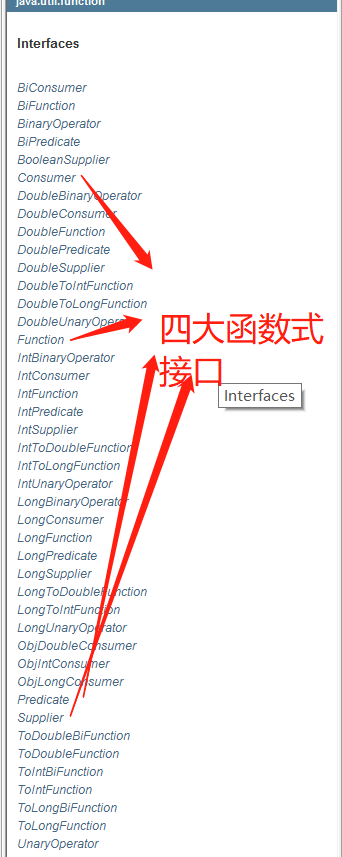
代码测试:
Function 函数式接口
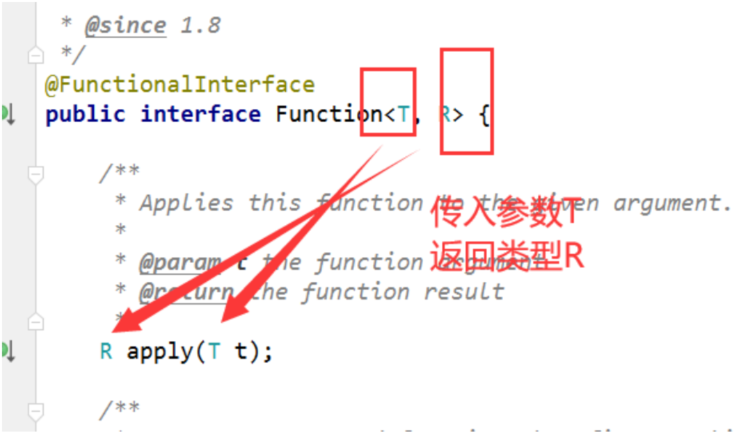
/**
* Function 函数型接口, 有一个输入参数,有一个输出
* 只要是 函数型接口 可以 用 lambda表达式简化
*/
public class Demo01 {
public static void main(String[] args) {
//
// Function<String,String> function = new Function<String,String>() {
// @Override
// public String apply(String str) {
// return str;
// }
// };
Function<String,String> function = (str)->{return str;};
System.out.println(function.apply("asd"));
}
}
断定型接口:有一个输入参数,返回值只能是布尔型

import java.util.function.Predicate;
/**
* 断定型接口:有一个输入参数,返回值只能是 布尔值!
*/
public class Demo02 {
public static void main(String[] args) {
// 判断字符串是否为空
// Predicate<String> predicate = new Predicate<String>(){
//// @Override
//// public boolean test(String str) {
//// return str.isEmpty();
//// }
//// };
Predicate<String> predicate = (str)->{return str.isEmpty(); };
System.out.println(predicate.test(""));
}
}
Consumer 消费型接口

import java.util.function.Consumer;
/**
* Consumer 消费型接口: 只有输入,没有返回值
*/
public class Demo03 {
public static void main(String[] args) {
// Consumer<String> consumer = new Consumer<String>() {
// @Override
// public void accept(String str) {
// System.out.println(str);
// }
// };
Consumer<String> consumer = (str)->{System.out.println(str);};
consumer.accept("sdadasd");
}
}
Supplier:供给型接口
import java.util.function.Supplier;
/**
* Supplier 供给型接口 没有参数,只有返回值
*/
public class Demo04 {
public static void main(String[] args) {
// Supplier supplier = new Supplier<Integer>() {
// @Override
// public Integer get() {
// System.out.println("get()");
// return 1024;
// }
// };
Supplier supplier = ()->{ return 1024; };
System.out.println(supplier.get());
}
}
13、Stream流式计算
什么是流式计算
大数据 :存储+计算
集合、MySQL本质就是存储东西的
计算都应该交给流来操作

/**
* 题目要求:一分钟内完成此题,只能用一行代码实现!
* 现在有5个用户!筛选:
* 1、ID 必须是偶数
* 2、年龄必须大于23岁
* 3、用户名转为大写字母
* 4、用户名字母倒着排序
* 5、只输出一个用户!
*/
public class StreamTest {
public static void main(String[] args) {
User u1 = new User(1,"a",21);
User u2 = new User(2,"b",22);
User u3 = new User(3,"c",23);
User u4 = new User(4,"d",24);
User u5 = new User(6,"e",25);
// 集合就是存储
List<User> list = Arrays.asList(u1, u2, u3, u4, u5);
// 计算交给stream流
// lambda表达式、链式编程、函数式接口、Stream流式计算
list.stream()
.filter((user)->{return user.getId()%2==0;})
.filter((user)->{return user.getAge()>23;})
.map((user -> {return user.getName().toUpperCase();}))
.sorted((uu1, uu2) -> {return uu2.compareTo(uu1);})
.limit(1)
.forEach(System.out::println);
}
}
14、ForkJoin
什么是ForkJoin
ForkJoin 在 JDK 1.7 , 并行执行任务!提高效率。大数据量!
大数据:Map Reduce (把大任务拆分为小任务)
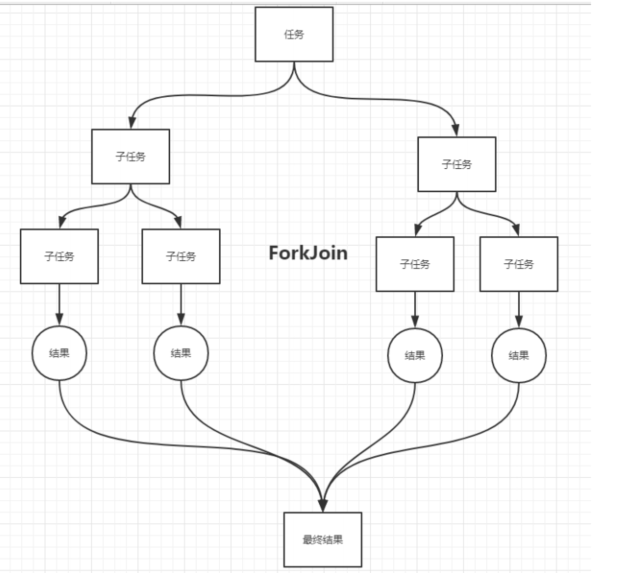
ForkJoin 特点:工作窃取
这个里面维护的都是双端队列
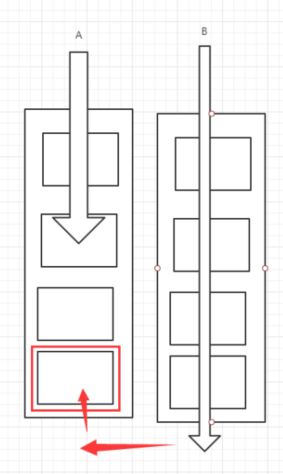
ForkJoin
ForkJoinPool

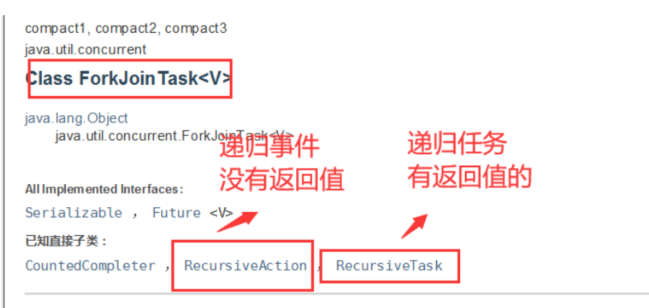
package com.mountain.forkjoin;
import java.util.concurrent.RecursiveTask;
/**
* 求和计算的任务!
* 3000 6000(ForkJoin) 9000(Stream并行流)
* // 如何使用 forkjoin
* // 1、forkjoinPool 通过它来执行
* // 2、计算任务 forkjoinPool.execute(ForkJoinTask task)
* // 3. 计算类要继承 ForkJoinTask
*/
public class ForkJoinDemo extends RecursiveTask<Long> {
private Long start; // 1
private Long end; // 1990900000
// 临界值
private Long temp = 10000L;
public ForkJoinDemo(Long start, Long end) {
this.start = start;
this.end = end;
}
// 计算方法
@Override
protected Long compute() {
if ((end-start)<temp) {
Long sum = 0L;
for (Long i = start; i < end; i++) {
sum += i;
}
return sum;
} else { // forkjoin 递归
long middle = (start+end)/2; // 中间值
ForkJoinDemo task1 = new ForkJoinDemo(start, middle);
task1.fork(); // 拆分任务,把任务压入线程队列
ForkJoinDemo task2 = new ForkJoinDemo(middle+1, end);
task2.fork(); // 拆分任务,把任务压入线程队列
return task1.join() + task2.join();
}
}
}
测试
package com.mountain.forkjoin;
import java.util.concurrent.ExecutionException;
import java.util.concurrent.ForkJoinPool;
import java.util.concurrent.ForkJoinTask;
import java.util.stream.LongStream;
/**
* 同一个任务,别人效率高你几十倍!
*/
public class ForkJoinTest {
public static void main(String[] args) throws ExecutionException, InterruptedException {
// test1();
// test2();
test3();
}
// 普通程序员
public static void test1() {
Long sum = 0L;
Long start = System.currentTimeMillis();
for (Long i = 1L; i < 10_0000_0000; i++) {
sum+=i;
}
long end = System.currentTimeMillis();
System.out.println("sum=" + sum + " 时间:" + (end - start));
}
// 会使用ForkJoin
public static void test2() throws ExecutionException, InterruptedException {
Long start = System.currentTimeMillis();
ForkJoinPool forkJoinPool = new ForkJoinPool();
ForkJoinDemo task = new ForkJoinDemo(0L, 10_0000_0000L);
ForkJoinTask<Long> submit = forkJoinPool.submit(task);
Long sum = submit.get();
long end = System.currentTimeMillis();
System.out.println("sum="+sum+" 时间:"+(end-start));
}
// Stream并行流
public static void test3() {
long start = System.currentTimeMillis();
// Stream并行流 rangeClosed:() (] parallel:并行 reduce:转换
LongStream.rangeClosed(0L, 10_0000_0000L).parallel().reduce(0, Long::sum);
long end = System.currentTimeMillis();
System.out.println("sum="+"时间:"+(end-start));
}
}
15、异步回调
Future 设计初衷:对将来的某个事件的结果进行建模
package com.mountain.future;
import java.util.concurrent.CompletableFuture;
import java.util.concurrent.ExecutionException;
import java.util.concurrent.TimeUnit;
/**
* 异步调用: CompletableFuture
* // 异步执行
* // 成功回调
* // 失败回调
*/
public class Demo01 {
public static void main(String[] args) throws ExecutionException, InterruptedException {
// 1、没有返回值的 runAsync 异步回调
CompletableFuture<Void> completableFuture = CompletableFuture.runAsync(() -> {
try {
TimeUnit.SECONDS.sleep(2);
} catch (Exception e) {
e.printStackTrace();
}
System.out.println(Thread.currentThread().getName() + " runAsync=> void");
});
System.out.println("1111");
completableFuture.get();
// 2、有返回值的 supplyAsync异步回调
CompletableFuture<Integer> uCompletableFuture = CompletableFuture.supplyAsync(() -> {
System.out.println(Thread.currentThread().getName() + "supplyAsync=>Integer");
try {
TimeUnit.SECONDS.sleep(10);
} catch (InterruptedException e) {
e.printStackTrace();
}
int i = 10/0;
return 1024;
});
System.out.println(uCompletableFuture.whenComplete((t, u) -> {
System.out.println("t=>" + t); // 正常的返回结果
System.out.println("u=>" + u); // 错误信息:
}).exceptionally((e) -> {
System.out.println(e.getMessage());
return 233; // 可以获取到错误的返回结果
}).get());
}
}
16、JMM
请你谈谈你对Volatile的理解
Volatile是java虚拟机提供的轻量级的同步机制
1、保证可见性
2、不保证原子性
3、禁止指令重排
什么是JMM
JMM:Java内存模型,不存在的东西,概念!约定!
关于JMM的一些同步约定:
1、线程解锁前,必须把共享变量立刻刷回主存
2、线程加锁前,必须读取主存中的最新值到工作内存中!
3、加锁和解锁是同一把锁
线程 工作内存 主存
内存交互操作有8种,虚拟机实现必须保证每一个操作都是原子的,不可在分的(对于double和long类型的变量来说,load、store、read和write操作在某些平台上允许例外)
-
lock (锁定):作用于主内存的变量,把一个变量标识为线程独占状态
-
unlock (解锁):作用于主内存的变量,它把一个处于锁定状态的变量释放出来,释放后的变量
才可以被其他线程锁定
-
read (读取):作用于主内存变量,它把一个变量的值从主内存传输到线程的工作内存中,以便
随后的load动作使用
-
load (载入):作用于工作内存的变量,它把read操作从主存中变量放入工作内存中
-
use (使用):作用于工作内存中的变量,它把工作内存中的变量传输给执行引擎,每当虚拟机
遇到一个需要使用到变量的值,就会使用到这个指令
-
assign (赋值):作用于工作内存中的变量,它把一个从执行引擎中接受到的值放入工作内存的变
量副本中
-
store (存储):作用于主内存中的变量,它把一个从工作内存中一个变量的值传送到主内存中,
以便后续的write使用
-
write (写入):作用于主内存中的变量,它把store操作从工作内存中得到的变量的值放入主内
存的变量中
JMM对这八种指令的使用,制定了如下规则:
-
不允许read和load、store和write操作之一单独出现。即使用了read必须load,使用了store必须
write
-
不允许线程丢弃他最近的assign操作,即工作变量的数据改变了之后,必须告知主存
-
不允许一个线程将没有assign的数据从工作内存同步回主内存
-
一个新的变量必须在主内存中诞生,不允许工作内存直接使用一个未被初始化的变量。就是怼变量
实施use、store操作之前,必须经过assign和load操作
-
一个变量同一时间只有一个线程能对其进行lock。多次lock后,必须执行相同次数的unlock才能解
锁
-
如果对一个变量进行lock操作,会清空所有工作内存中此变量的值,在执行引擎使用这个变量前,
必须重新load或assign操作初始化变量的值
-
如果一个变量没有被lock,就不能对其进行unlock操作。也不能unlock一个被其他线程锁住的变量
-
对一个变量进行unlock操作之前,必须把此变量同步回主内存
问题: 程序不知道主内存的值已经被修改过了

17、Volatile
1、保证可见性
public class JMMDemo{
// 不加volatile 程序就会死循环
// 加volatile 可以保证可见性
private volatile static int num = 0;
public static void main(String args) {
new Thread(()->{
while(num==0) {
}
}).start();
try {
TimeUnit.SECONDS.sleep(1);
} catch (InterruptedException e) {
e.printStackTrace();
}
num = 1;
System.out.println(num);
}
}
2、不保证原子性
原子性:不可分割
线程A在执行任务的时候,不能被打扰的,也不能被分割。要么同时成功,要么同时失败。
// volatile 不保证原子性
public class VDemo02{
// volatile 不保证原子性
private volatile static int num = 0;
public static void add() {
num++;
}
public static void main(String[] args) {
// 理论上num结果应该为2万
for(int i = 1; i<=20; i++) {
new Thread(()->{
for(int j=0; j<1000; j++){
add();
}
}).start();
}
while(Thread.activeCount()>2) { // hread.activeCount()可以得出现在运行的线程数
Thread.yield();
}
System.out.println(Thread.currentThread().getName() + " " + num);
}
}
如果不加 lock 和 synchronized ,怎么样保证原子性
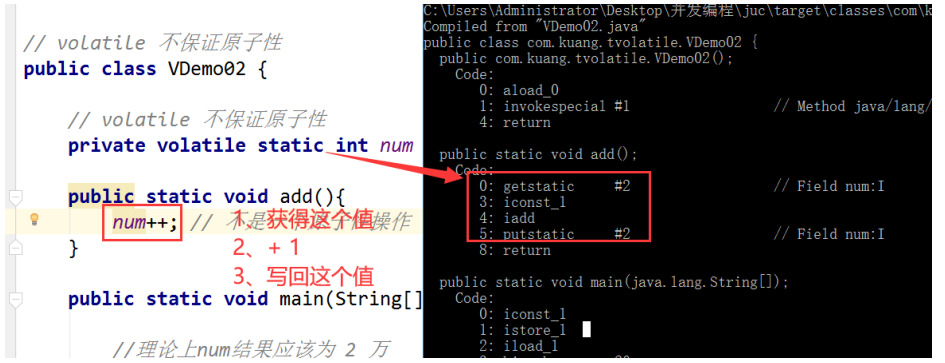
使用原子类,解决 原子性问题
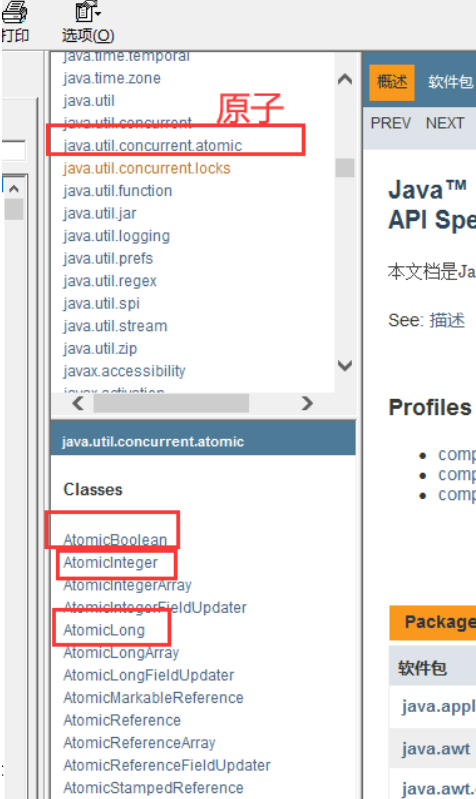
package com.mountain.tvolatile;
import java.util.concurrent.atomic.AtomicInteger;
// volatile 不保证原子性
public class VDemo02 {
// volatile 不保证原子性
// 原子类的 Integer
private volatile static AtomicInteger num = new AtomicInteger();
public static void add(){
// num++; // 不是一个原子性操作
num.getAndIncrement(); // AtomicInteger + 1 方法, CAS
}
public static void main(String[] args) {
//理论上num结果应该为 2 万
for (int i = 1; i <= 20; i++) {
new Thread(()->{
for (int j = 0; j < 1000 ; j++) {
add();
}
}).start();
}
while (Thread.activeCount()>2){ // main gc
Thread.yield();
}
System.out.println(Thread.currentThread().getName() + " " + num);
}
}
这些类的底层都直接和操作系统挂钩!在内存中修改值!Unsafe类是一个很特殊的存在!
指令重排
什么是指令重排:你写的程序,计算机并不是按照你写的那样去执行
源代码-->编译器优化的重排-->指令并行也可能会重排-->内存系统也会重排-->执行
处理器在进行指令重排的时候,考虑:数据之间的依赖性!
int x = 1; // 1
int y = 2; // 2
x = x + 5; // 3
y = x * x; // 4
我们所期望的:1234 但是可能执行的时候回变成 2134 1324
可不可能是 4123!
可能造成影响的结果: a b x y 这四个值默认都是 0;
| 线程A | 线程B |
|---|---|
| x=a | y=b |
| b=1 | a=2 |
正常的结果: x = 0;y = 0;但是可能由于指令重排
| 线程A | 线程B |
|---|---|
| b=1 | a=2 |
| x=a | y=b |
指令重排导致的诡异结果: x = 2;y = 1;
非计算机专业
volatile可以避免指令重排:
内存屏障。CPU指令。作用:
1、保证特定的操作的执行顺序!
2、可以保证某些变量的内存可见性 (利用这些特性volatile实现了可见性)

Volatile 是可以保持 可见性。不能保证原子性,由于内存屏障,可以保证避免指令重排的现象产生!
18、彻底玩转单例模式
饿汉式 DCL懒汉式,深究!
饿汉模式
package com.mountain.single;
/**
* 饿汉模式单例
*/
public class Hungry {
// 可能会浪费空间
private byte[] data1 = new byte[1024*1024];
private byte[] data2 = new byte[1024*1024];
private byte[] data3 = new byte[1024*1024];
private byte[] data4 = new byte[1024*1024];
public Hungry() {
}
private static final Hungry HUNGRY = new Hungry();
public static Hungry getInstance() {
return HUNGRY;
}
}
DCL 懒汉式
package com.mountain.single;
import java.lang.reflect.Constructor;
import java.lang.reflect.Field;
// 懒汉式单例
// 道高一尺,魔高一丈!
public class LazyMan {
private static boolean mountain = false;
private LazyMan(){
synchronized (LazyMan.class) {
if (mountain == false) {
mountain = true;
} else {
throw new RuntimeException("不要试图使用反射破坏异常");
}
}
}
private static LazyMan lazyMan;
// 双重检测锁模式的 懒汉式单例 DCL懒汉式
public static LazyMan getInstance() {
if (lazyMan == null) {
synchronized (LazyMan.class) {
if (lazyMan == null) {
lazyMan = new LazyMan();
}
}
}
return lazyMan;
}
// 反射!
public static void main(String[] args) throws Exception {
// LazyMan instance = LazyMan.getInstance();
Field mountain = LazyMan.class.getDeclaredField("mountain");
mountain.setAccessible(true);
Constructor<LazyMan> declaredConstructor =
LazyMan.class.getDeclaredConstructor(null);
declaredConstructor.setAccessible(true);
LazyMan instance = declaredConstructor.newInstance();
mountain.set(instance,false);
LazyMan instance2 = declaredConstructor.newInstance();
System.out.println(instance);
System.out.println(instance2);
}
}
/**
* 1. 分配内存空间
* 2、执行构造方法,初始化对象
* 3、把这个对象指向这个空间
*
* 123
* 132 A
* B // 此时lazyMan还没有完成构造
*/
静态内部类
package com.mountain.single;
// 静态内部类
public class Holder {
private Holder() {}
public static Holder getInstance() {
return InnerClass.HOLDER;
}
public static class InnerClass {
private static final Holder HOLDER = new Holder();
}
}
单例不安全,反射
枚举
package com.mountain.single;
import java.lang.reflect.Constructor;
import java.lang.reflect.InvocationTargetException;
// enum 是一个什么? 本身也是一个Class类
public enum EnumSingle {
INSTANCE;
public EnumSingle getInstance() {
return INSTANCE;
}
}
class Test{
public static void main(String[] args) throws NoSuchMethodException,
IllegalAccessException, InvocationTargetException, InstantiationException {
EnumSingle instance1 = EnumSingle.INSTANCE;
Constructor<EnumSingle> declaredConstructor =
EnumSingle.class.getDeclaredConstructor(String.class,int.class);
declaredConstructor.setAccessible(true);
EnumSingle instance2 = declaredConstructor.newInstance();
// NoSuchMethodException: com.kuang.single.EnumSingle.<init>()
System.out.println(instance1);
System.out.println(instance2);
}
}

枚举类型的最终反编译源码:
// Decompiled by Jad v1.5.8g. Copyright 2001 Pavel Kouznetsov.
// Jad home page: http://www.kpdus.com/jad.html
// Decompiler options: packimports(3)
// Source File Name: EnumSingle.java
package com.kuang.single;
public final class EnumSingle extends Enum{
public static EnumSingle[] values(){
return (EnumSingle[])$VALUES.clone();
}
public static EnumSingle valueOf(String name){
return (EnumSingle)Enum.valueOf(com/kuang/single/EnumSingle, name);
}
private EnumSingle(String s, int i){
super(s, i);
}
public EnumSingle getInstance(){
return INSTANCE;
}
public static final EnumSingle INSTANCE;
private static final EnumSingle $VALUES[];
static{
INSTANCE = new EnumSingle("INSTANCE", 0);
$VALUES = (new EnumSingle[] {
INSTANCE
});
}
}
19、深入理解CAS
什么是CAS
大厂你必须要深入研究底层!有所突破! 修内功,操作系统,计算机网络原理
package com.mountain.cas;
import java.util.concurrent.atomic.AtomicInteger;
/**
* @Author: mountian
*/
public class CASDemo {
// CAS compareAndSet : 比较并交换!
public static void main(String[] args) {
AtomicInteger atomicInteger = new AtomicInteger(2022);
// 期望、更新
// public final boolean compareAndSet(int expect, int update)
// 如果我期望的值达到了,那么就更新,否则,就不更新, CAS 是CPU的并发原语!
System.out.println(atomicInteger.compareAndSet(2020, 2021));
System.out.println(atomicInteger.get());
atomicInteger.getAndIncrement(); // 自增
System.out.println(atomicInteger.compareAndSet(2020, 2021));
System.out.println(atomicInteger.get());
}
}
Unsafe 类
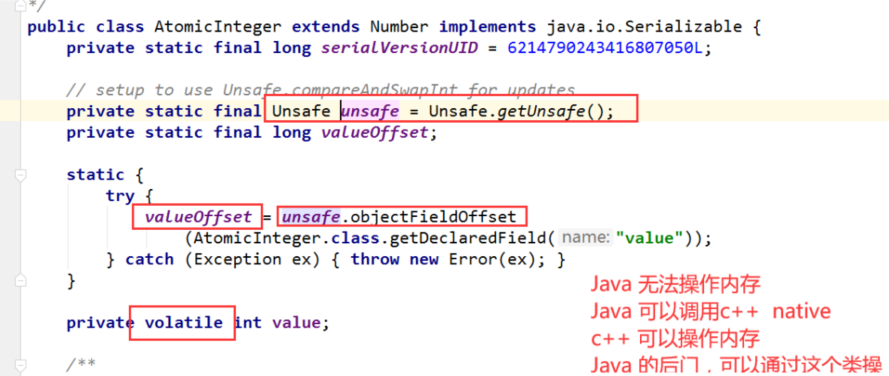
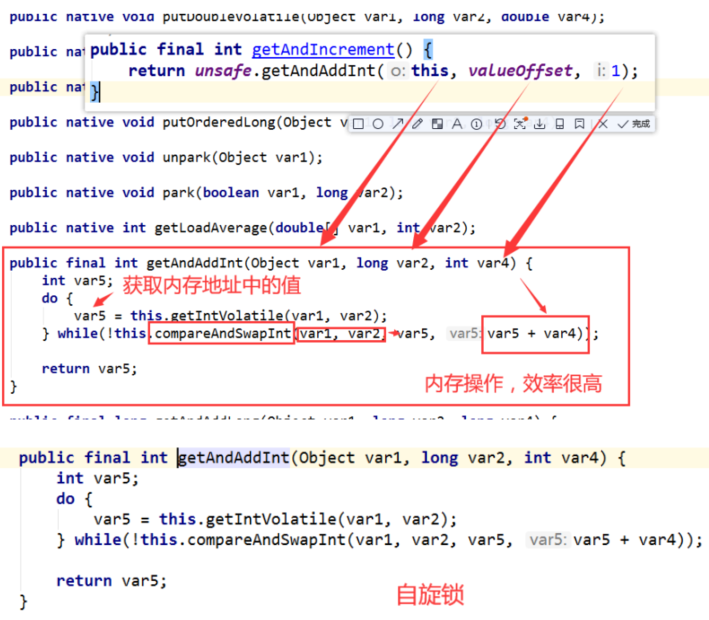
CAS :
比较当前工作内存中的值和主内存中的值,如果这个值是期望的,那么则执行操作!如果不是就一直循环!
缺点:
1、 循环会耗时
2、一次性只能保证一个共享变量的原子性
3、ABA问题
CAS : ABA 问题(狸猫换太子)
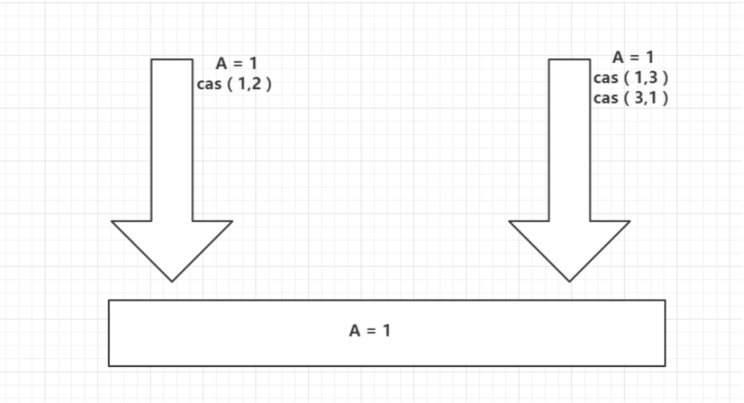
package com.mountain.cas;
import java.util.concurrent.atomic.AtomicInteger;
/**
* @Author: mountian
*/
public class CASDemo {
// CAS compareAndSet : 比较并交换!
public static void main(String[] args) {
AtomicInteger atomicInteger = new AtomicInteger(2022);
// 期望、更新
// public final boolean compareAndSet(int expect, int update)
// 如果我期望的值达到了,那么就更新,否则,就不更新, CAS 是CPU的并发原语!
// ============== 捣乱的线程 ==================
System.out.println(atomicInteger.compareAndSet(2020, 2021));
System.out.println(atomicInteger.get());
System.out.println(atomicInteger.compareAndSet(2021, 2020));
System.out.println(atomicInteger.get());
// ============== 期望的线程 ==================
System.out.println(atomicInteger.compareAndSet(2020, 6666));
System.out.println(atomicInteger.get());
}
}
20、原子引用
解决ABA问题,引入原子引用!对应的思想:乐观锁
带版本号的原子操作!
package com.mountain.cas;
import lombok.experimental.var;
import java.util.concurrent.TimeUnit;
import java.util.concurrent.atomic.AtomicStampedReference;
/**
* @Author: mountian
* @Description: 原子引用
*/
public class CASDemo02 {
// AtomicStampedReference 注意 如果泛型是一个包装类, 注意对象的引用问题
// 正常在业务操作,这里面比较的都是一个个对象
static AtomicStampedReference<Integer> atomicStampedReference =
new AtomicStampedReference<Integer>(1, 1);
public static void main(String[] args) {
new Thread(()->{
int stamp = atomicStampedReference.getReference(); // 获得版本号
System.out.println("a1 => " + stamp);
try {
TimeUnit.SECONDS.sleep(1);
} catch (InterruptedException e) {
e.printStackTrace();
}
atomicStampedReference.compareAndSet(1,
2,
atomicStampedReference.getStamp(),
atomicStampedReference.getStamp() + 1);
System.out.println("a2=>"+atomicStampedReference.getStamp());
System.out.println(atomicStampedReference.compareAndSet(2, 1,
atomicStampedReference.getStamp(),
atomicStampedReference.getStamp() + 1));
System.out.println("a3=>"+atomicStampedReference.getStamp());
}, "a").start();
// 乐观锁的原理相同!
new Thread(()->{
int stamp = atomicStampedReference.getStamp(); // 获得版本号
System.out.println("b1=>"+stamp);
try {
TimeUnit.SECONDS.sleep(2);
} catch (InterruptedException e) {
e.printStackTrace();
}
System.out.println(atomicStampedReference.compareAndSet(1, 6,
stamp, stamp + 1));
System.out.println("b2=>"+atomicStampedReference.getStamp());
},"b").start();
}
}
注意:
Integer 使用了对象缓存机制,默认范围是 -128 ~ 127 ,推荐使用静态工厂方法 valueOf 获取对象实
例,而不是 **new,因为 **valueOf 使用缓存,而 new 一定会创建新的对象分配新的内存空间;

21、各种锁的理解
1、公平锁、非公平锁
公平锁: 非常公平, 不能够插队,必须先来后到!
非公平锁:非常不公平,可以插队 (默认都是非公平)
public ReentrantLock() {
sync = new NonfairSync();
}
public ReentrantLock(boolean fair) {
sync = fair ? new FairSync() : new NonfairSync();
}
2、可重入锁
可重入锁(递归锁)

Synchronized
import javax.sound.midi.Soundbank;
// Synchronized
public class Demo01 {
public static void main(String[] args) {
Phone phone = new Phone();
new Thread(()->{
phone.sms();
},"A").start();
new Thread(()->{
phone.sms();
},"B").start();
}
}
class Phone{
public synchronized void sms(){
System.out.println(Thread.currentThread().getName() + "sms");
call(); // 这里也有锁
}
public synchronized void call(){
System.out.println(Thread.currentThread().getName() + "call");
}
}
Lock 版
import java.util.concurrent.locks.Lock;
import java.util.concurrent.locks.ReentrantLock;
public class Demo02 {
public static void main(String[] args) {
Phone2 phone = new Phone2();
new Thread(()->{
phone.sms();
},"A").start();
new Thread(()->{
phone.sms();
},"B").start();
}
}
class Phone2{
Lock lock = new ReentrantLock();
public void sms(){
// 细节问题:lock.lock(); lock.unlock(); // lock 锁必须配对,否则就会死在里面
lock.lock();
lock.lock();
try {
System.out.println(Thread.currentThread().getName() + "sms");
call(); // 这里也有锁
} catch (Exception e) {
e.printStackTrace();
} finally {
lock.unlock();
lock.unlock();
}
}
public void call(){
lock.lock();
try {
System.out.println(Thread.currentThread().getName() + "call");
} catch (Exception e) {
e.printStackTrace();
} finally {
lock.unlock();
}
}
}
3、自旋锁
spinlock

我们来自定义一个锁测试
import java.util.concurrent.atomic.AtomicReference;
/**
* 自旋锁
*/
public class SpinlockDemo {
// int 0
// Thread null
AtomicReference<Thread> atomicReference = new AtomicReference<>();
// 加锁
public void myLock(){
Thread thread = Thread.currentThread();
System.out.println(Thread.currentThread().getName() + "==> mylock");
// 自旋锁
while (!atomicReference.compareAndSet(null,thread)){
}
}
// 解锁
// 加锁
public void myUnLock(){
Thread thread = Thread.currentThread();
System.out.println(Thread.currentThread().getName() + "==> myUnlock");
atomicReference.compareAndSet(thread,null);
}
}
测试
import java.util.concurrent.TimeUnit;
import java.util.concurrent.locks.ReentrantLock;
public class TestSpinLock {
public static void main(String[] args) throws InterruptedException {
// ReentrantLock reentrantLock = new ReentrantLock();
// reentrantLock.lock();
// reentrantLock.unlock();
// 底层使用的自旋锁CAS
SpinlockDemo lock = new SpinlockDemo();
new Thread(()-> {
lock.myLock();
try {
TimeUnit.SECONDS.sleep(5);
} catch (Exception e) {
e.printStackTrace();
} finally {
lock.myUnLock();
}
},"T1").start();
TimeUnit.SECONDS.sleep(1);
new Thread(()-> {
lock.myLock();
try {
TimeUnit.SECONDS.sleep(1);
} catch (Exception e) {
e.printStackTrace();
} finally {
lock.myUnLock();
}
},"T2").start();
}
}

4、死锁
死锁是什么
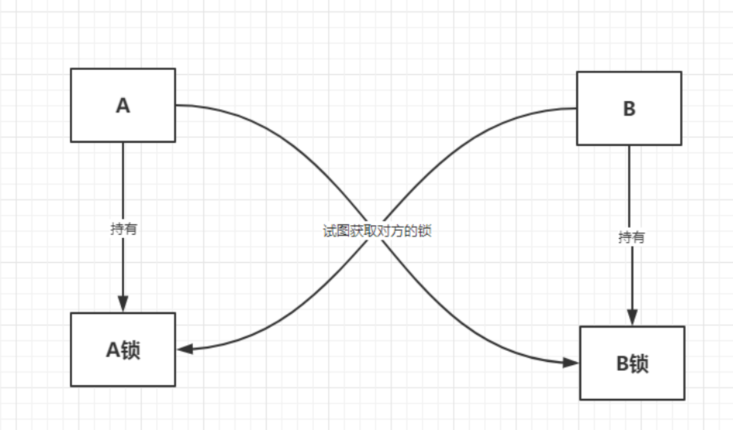
死锁测试,怎么排除死锁:
import com.sun.org.apache.xpath.internal.SourceTree;
import java.util.concurrent.TimeUnit;
public class DeadLockDemo {
public static void main(String[] args) {
String lockA = "lockA";
String lockB = "lockB";
new Thread(new MyThread(lockA, lockB), "T1").start();
new Thread(new MyThread(lockB, lockA), "T2").start();
}
}
class MyThread implements Runnable{
private String lockA;
private String lockB;
public MyThread(String lockA, String lockB) {
this.lockA = lockA;
this.lockB = lockB;
}
@Override
public void run() {
synchronized (lockA){
System.out.println(Thread.currentThread().getName() +"lock:"+lockA+"=>get"+lockB);
try {
TimeUnit.SECONDS.sleep(2);
} catch (InterruptedException e) {
e.printStackTrace();
}
synchronized (lockB){
System.out.println(Thread.currentThread().getName() +
"lock:"+lockB+"=>get"+lockA);
}
}
}
}
解决问题
1、使用 jps -l 定位进程号

2、使用 jstack 进程号 找到死锁问题
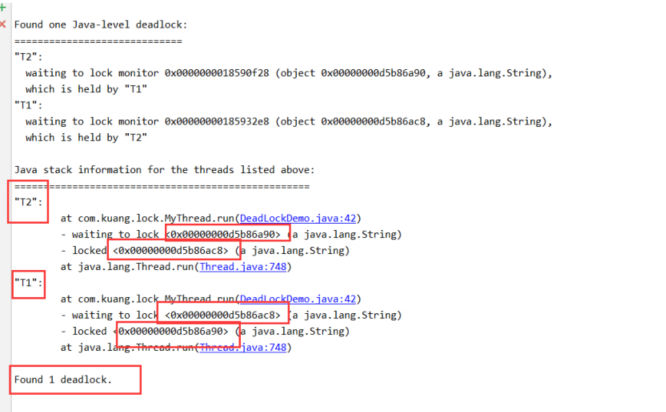
面试,工作中!
排查问题:
1、日志 9
2、堆栈 1
标签:JUC,System,线程,println,new,狂神,多线程,public,out From: https://www.cnblogs.com/smountain/p/17047844.html